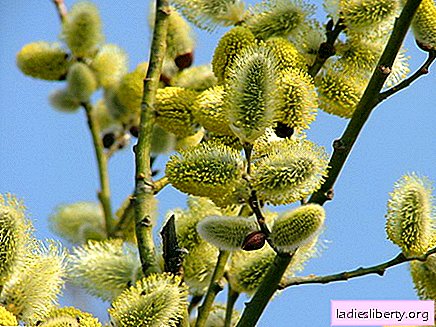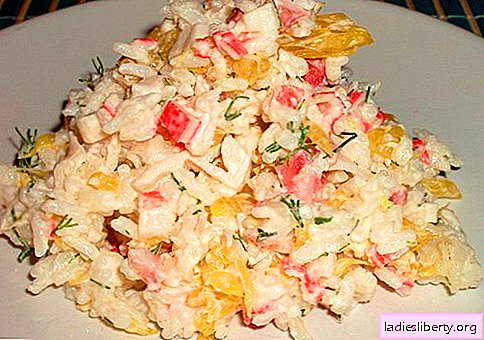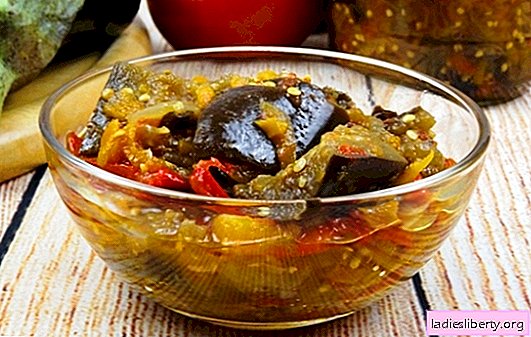
Willow - general description
Pussy-willow is a variety of willow goat, silver (white) or wolf-neck (hook). It is a tree or shrub of the willow family with a spreading hemispherical crown, with a characteristic smooth bark of a grayish color, and on young shoots it is reddish and fluffy gray buds. Willow has narrow lanceolate, oblong and smooth to the touch leaves with sharp-edged edges.
Flowering usually lasts from April to May until the young leaves bloom. Twigs are plastic, flexible, and, due to their property, quite often are frame and structural material. Shrubs are widely used in floristry. Perhaps the willow is an integral traditional part of the Easter and spring compositions.
Willow - types and places of growth
The genus of willow has about 300 species. What we call willow are just a few forms of willow.
1. Goat willow - its range covers all of Europe, except for the alpine belt and tundra, Asia, Russia, the Caucasus. It lives mainly in moist forests of various compositions, along roads, at the edges, clearings; prefers rich soil, not swampy and not too moist.
2. Silver willow - distributed in Europe, Asia Minor, Iran, almost throughout Russia. It grows mainly along the banks of rivers, reservoirs, ponds, irrigation ditches, as well as along roads and private sectors. White willow is an integral element complementing the natural landscape of large parks located on the banks of large reservoirs.
3. Wolf willow - concentrated in Europe, Russia. The photophilous plant grows on sandy or loamy soils, near water bodies.
Willow - healing properties
From time immemorial, willow has been used by the people to treat various ailments. It has astringent, antipyretic, anti-inflammatory, hemostatic, diuretic, moderately analgesic, choleretic and anthelmintic actions. Thanks to a rich complex of biologically active substances, it helps to combat diseases such as gout, rheumatism, diarrhea, bleeding, malaria, inflammatory diseases of the oral cavity, arrhythmias, jaundice.
It is also widely used as a remedy against varicose veins, migraines, furunculosis, sweating feet and to strengthen the gums. Tea from young leaves of the tree has a tonic effect, helps get rid of depression and cheer up. And with the help of a willow broom in a steam room, osteochondrosis and chronic rheumatism are treated.
Willow - dosage forms
For medicinal purposes, bark is usually used, less often leaves. Bark is collected from trees no younger than 2-3 years old, in the spring, before the first leaves appear. Dry it in ventilated places, laying it out in a thin layer. It is necessary to store the finished extract in a cardboard container for no more than four years. Young leaves of the plant are also useful, on the basis of which decoctions, infusions and pulp are also made.
Willow - recipes
Infusion for rinsing and strengthening the nervous system: add 400 g of boiling water to the table. spoon bark, wrap and insist a couple of hours. With a warm liquid, you can rinse the ulcerated oral cavity or take it in the throat three r. in a day.
With muscle overwork, use this method: 6 liters are boiled in a liter of water. tablespoons of the root extract, filtered and used in the form of relaxing baths for feet, calves.
In case of varicose veins: a handful of crushed dry willow bark should be boiled with boiling water in a bowl or bucket, let it brew and cool to a comfortable temperature. Then lower the legs into a healing infusion, hold for several minutes. Multiple (up to 3 times) use of the solution is possible, followed by heating. Number of procedures - 7-8 baths.
Diarrhea, gastrointestinal bleeding, gastritis, peptic ulcer: add a handful of white willow roots to 200 ml of water, boil for half an hour. Cool and take before eating a tablespoon.
Tincture for the prevention of migraine attacks: add half a liter of quality 40% vodka to 25 g of willow roots, insist in a dark isolated place for ten days, then be sure to strain and take 30 cap. Diluted in a small amount of water before eating, three - four times a day.
For skin diseases, furunculosis, corns and corns, young leaves can be applied to problem areas or gruel can be used for the same purpose.
Willow - contraindications
- pregnancy, breastfeeding;
- hypersensitivity.
Also, the simultaneous use of drugs from willow with aspirin, antacids and anti-cough, colds.
Comments











